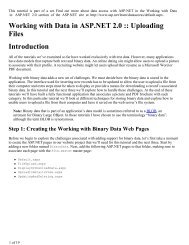

The server parses the request, handles it (for example, saves files on a hard disk), and sends a response to the client side. The client application packs these files to a POST request and sends it to the server. A user visits a web page and chooses files to upload. Let’s consider the usual upload scenario: There are always two parts, the client and server sides, that communicate with each other through HTTP requests and responses. In this article we consider different ways of file upload in ASP.NET and discuss their use, but before let’s see how file upload works in general. Thus, it is essential to choose the one that suits your requirements best: whether it is uploading a few files one by one or multiple files at a time, working with files of small or very large size, sending entire folders or files only, having a simple image upload or preprocessing images beforehand. There are a number of different upload approaches in ASP.NET. The chief thing is that file upload should be fast, easy, and reliable. The NodeContent property will contain the text to be included inside the node, removing any information that was previously on the original node.Nowadays you may find file upload in almost every website – from forums that allow users to upload photos for their avatars, to online auctions where users can create galleries with a lot of images. In our case, we will almost always add the attribute value, followed by the value we want that attribute to take. "OverrideCriticalLevelWith ": "Critical ",Īs you can see, the property is an array, where you can define overri elements.Įach element on this array can be defined as an object with XPath property, which will contain the XPath expression to find the node on log4net configuration file from which we want to overwrite its information, and Attributes property, that should contain a list of all the attributes you want to overwrite. Add a property on your log4net configuration section named PropertyOverrides. To do this, you will need to do the following: To do this, this package includes the possibility of overwriting the information of a node or the attributes of that node using the Net Core configuration system. This might be interesting if we want to use a different name for each environment deployed. Sometimes we might want to modify the value of an appender, for example, the file name of our log. Overwriting the native log4net XML configuration using Log4NetProviderOptions Not compatible with UseWebOrAppConfig, ExternalConfigurationSetup, Watch Json values that allow define value replacements during the log4net initialization. See modifying logging behaviour for more information. Not compatible with UseWebOrAppConfig, ExternalConfigurationSetup, PropertyOverridesĪllows to setup the Critical Level message written with another Level category. Indicates that the nfig file will be opened in watch mode, aka any change will reload log4net configuration. Not compatible with UseWebOrAppConfig, Watch, PropertyOverrides, Log4NetConfigFileName Indicates to the Log4NetProvider that the log4net library have been configured outside of the extension using XmlConfigurator Not compatible with ExternalConfigurationSetup, Watch, PropertyOverrides, Log4NetConfigFileName Public IConfiguration Configuration Log4NetProviderOptions 'specials' reference Propertyįlag to indicate if the log4net configuration section is located on the app.config / web.config file. 
Public Startup( IConfiguration configuration) Add the AddLog4Net() call into your Configure method of the Startup class.
Asp.net upload file hasfile always false install#
Install the package or reference the project into your ASP.For more information about log4net configuration files, please take a look into the configuration files section on the oficial documentation for Log4Net Basic configuration






 0 kommentar(er)
0 kommentar(er)
